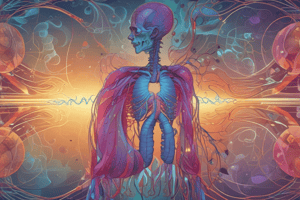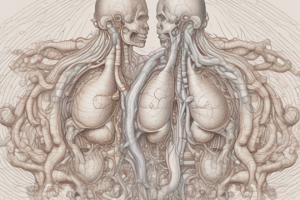Podcast
Questions and Answers
The surface area of alveoli has no effect on the rate of gas exchange.
The surface area of alveoli has no effect on the rate of gas exchange.
False (B)
The pneumotaxic center regulates the rate and depth of breathing.
The pneumotaxic center regulates the rate and depth of breathing.
True (A)
The diaphragm is the primary muscle of expiration.
The diaphragm is the primary muscle of expiration.
False (B)
An increase in temperature increases oxygen binding to hemoglobin.
An increase in temperature increases oxygen binding to hemoglobin.
CO2 is primarily transported in the blood as bicarbonate ions.
CO2 is primarily transported in the blood as bicarbonate ions.
Increased ventilation rate decreases CO2 removal.
Increased ventilation rate decreases CO2 removal.
The dorsal respiratory group regulates forced breathing.
The dorsal respiratory group regulates forced breathing.
Stretch receptors detect changes in CO2 levels in the blood.
Stretch receptors detect changes in CO2 levels in the blood.
Flashcards are hidden until you start studying
Study Notes
Gas Exchange
- Occurs in alveoli, tiny sacs in lungs where oxygen diffuses into blood and carbon dioxide diffuses out
- Factors affecting gas exchange:
- Surface area: increased surface area of alveoli increases rate of gas exchange
- Thickness of alveolar membrane: thinner membrane allows for faster diffusion
- Partial pressure gradient: greater difference in partial pressures of oxygen and carbon dioxide between alveoli and blood facilitates diffusion
- Ventilation and perfusion: matching of airflow and blood flow to alveoli ensures efficient gas exchange
Breathing Regulation
- Controlled by respiratory centers in brainstem:
- Dorsal respiratory group: regulates rhythmic breathing
- Ventral respiratory group: regulates forced breathing
- Pneumotaxic center: regulates rate and depth of breathing
- Feedback mechanisms:
- Chemoreceptors: detect changes in CO2 and O2 levels, sending signals to respiratory centers
- Stretch receptors: detect changes in lung volume, sending signals to respiratory centers
Respiratory Muscles
- Diaphragm: primary muscle of inspiration, contracts to increase chest cavity volume
- Intercostal muscles: secondary muscles of inspiration, contract to expand chest cavity
- Accessory muscles:
- Scalene muscles: help lift chest cavity
- Sternocleidomastoid muscles: help lift chest cavity
- Pectoral muscles: help expand chest cavity
- Expiration:
- Diaphragm relaxes, decreasing chest cavity volume
- Intercostal muscles relax, decreasing chest cavity volume
Oxygen Transport
- Oxygen binds to hemoglobin in red blood cells:
- Hemoglobin has high affinity for oxygen, allowing efficient transport
- Oxygen-hemoglobin dissociation curve: sigmoidal curve showing percentage of oxygen saturation at different partial pressures
- Factors affecting oxygen transport:
- pH: acidic environment decreases oxygen binding to hemoglobin
- Temperature: increased temperature decreases oxygen binding to hemoglobin
- 2,3-BPG: increased levels of 2,3-bisphosphoglycerate decrease oxygen binding to hemoglobin
CO2 Removal
- CO2 transported in blood as:
- Carbon dioxide dissolved in plasma
- Bicarbonate ions
- Carbaminohemoglobin (CO2 bound to hemoglobin)
- CO2 removal in lungs:
- CO2 diffuses out of blood into alveoli
- Exhaled out of body through exhalation
- Factors affecting CO2 removal:
- Ventilation rate: increased ventilation rate increases CO2 removal
- Blood flow: increased blood flow to lungs increases CO2 removal
Gas Exchange
- Oxygen diffuses into blood and carbon dioxide diffuses out in alveoli
- Increased surface area of alveoli increases rate of gas exchange
- Thinner alveolar membrane allows for faster diffusion
- Greater difference in partial pressures of oxygen and carbon dioxide facilitates diffusion
- Matching of airflow and blood flow to alveoli ensures efficient gas exchange
Breathing Regulation
- Respiratory centers in brainstem regulate breathing
- Dorsal respiratory group regulates rhythmic breathing
- Ventral respiratory group regulates forced breathing
- Pneumotaxic center regulates rate and depth of breathing
- Chemoreceptors detect changes in CO2 and O2 levels, sending signals to respiratory centers
- Stretch receptors detect changes in lung volume, sending signals to respiratory centers
Respiratory Muscles
- Diaphragm is the primary muscle of inspiration, increasing chest cavity volume
- Intercostal muscles are secondary muscles of inspiration, expanding chest cavity
- Scalene muscles help lift chest cavity
- Sternocleidomastoid muscles help lift chest cavity
- Pectoral muscles help expand chest cavity
- Diaphragm relaxes, decreasing chest cavity volume during expiration
- Intercostal muscles relax, decreasing chest cavity volume during expiration
Oxygen Transport
- Oxygen binds to hemoglobin in red blood cells with high affinity
- Oxygen-hemoglobin dissociation curve shows percentage of oxygen saturation at different partial pressures
- Acidic environment decreases oxygen binding to hemoglobin
- Increased temperature decreases oxygen binding to hemoglobin
- Increased 2,3-BPG levels decrease oxygen binding to hemoglobin
CO2 Removal
- CO2 is transported in blood as dissolved CO2, bicarbonate ions, and carbaminohemoglobin
- CO2 diffuses out of blood into alveoli in lungs
- CO2 is exhaled out of body through exhalation
- Increased ventilation rate increases CO2 removal
- Increased blood flow to lungs increases CO2 removal
Studying That Suits You
Use AI to generate personalized quizzes and flashcards to suit your learning preferences.




